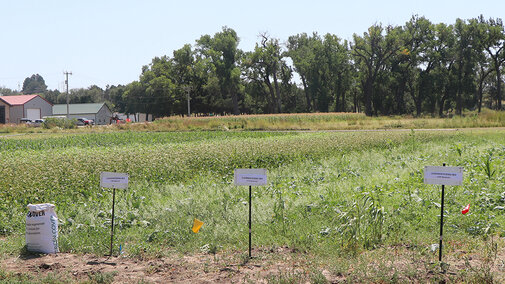The University of Nebraska-Lincoln, West Central Research Extension and Education Center held its annual Water and Crops Field Day on Aug. 24 in North Platte. One of the main topics in the morning dealt with cover crops. While cover crops are not a new idea, it has taken a while for them to become more mainstream.
“People planted cover crops in the ‘40s and ‘50s. It's nothing new, just refiguring it out,” said Jimmy Emmons, farmer and rancher from northwest Oklahoma. “It’s very important to figure out cover crops to keep that ground covered and warm in the winter and cool in the summer for biological activity in the ground.”
David Brandt, who has been doing cover crops since the 1970s, inspired Emmons to try cover crops.
“I asked David if cover crops would work for me in Oklahoma, and he said I would need to adapt my cover crops to rainfall, climate and environment, and they would work for me,” Emmons said.
Producers looking at putting in cover crops should start small, and Emmons suggested side-by-side trails with diversity.
Don Batie, a farmer in Dawson County, Nebraska and another member of the panel, agreed with Emmons. He grows irrigated corn, wheat and soybeans and finds his cover crops perform best after a soybean crop.
“You have to be patient. It was my second or third year before I saw benefits after my soybean crop,” Batie said. “The soil was softer, and even though we had cover crops using moisture, we had better moisture for our corn to grow, and multiple (cover crop) species helped.”
Batie started with no-till and moved on to strip-till practices before adding cover crops to reduce erosion, dust and water loss — just a few advantages brought about by implementing cover crops.
“What we’ve been looking at advantages cover crops can bring to the system (farming) such as weed suppression, soil erosion control, and ultimately soil organic carbon we want to sequester in the soil over time,” said Alex Rosa, Bayer Water Utilization Learning Center agronomist in Gothenburg, Nebraska.
For producers in dryland areas, Rosa suggests radishes, grasses and hairy vetch following soybeans. All three men advise patience is a big key in whatever benefits you are looking for with cover crops. Most of them will take years to build up — especially carbon matter — and field fertility, in general, takes longer. Benefits can also include weed suppression; Rosa added that farmers should combine cover crops with herbicides for the best suppression.
“Start small, try doing a few acres and work with the University (University of Nebraska-Lincoln) and on-farm research,” Batie said. “You need to see the effects with and without cover crops, so you need the documentation and extra numbers.”
To learn more about getting involved with on-farm research, visit Nebraska On-Farm Research Network, and for more on cover crops, see CropWatch.

